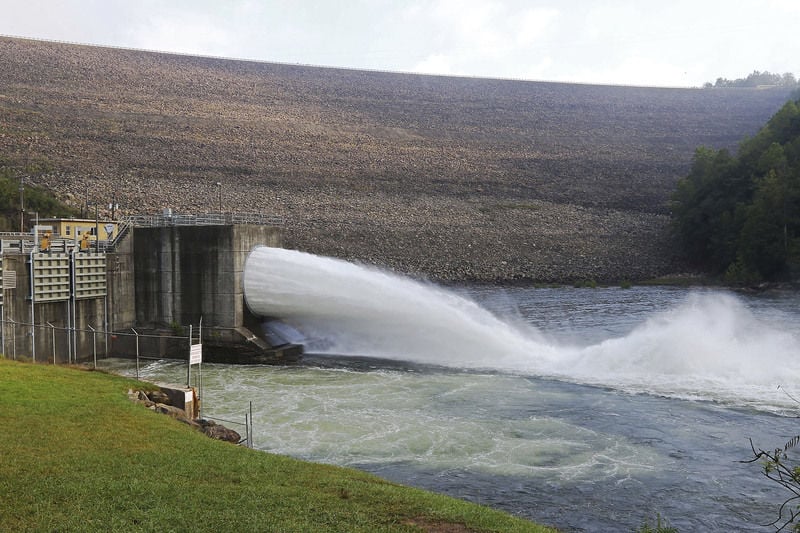In between the mountains in West Virginia, there lies the Gauley river. The Gauley River is an intense 105-mile track with an average discharge of 2680 cu ft/s, reaching 12900 cu ft/s with summer storms of 2016. These violent water rates are only heightened by the extraordinary rock formations that put this river as one of the most brutal in the US. Most of the rapids in the Upper Gauley are Category 5-4, the whitewater rating system being from 1 to 5: 5 being most dangerous. I had the opportunity to ride this river over the recent NCSU fall break. it was definitely one of the more challenging rivers I’ve been on, taking more than six hours to get through. Thousands upon thousands of rafters take on the challenge, most of them falling out. My mother actually rode the river in the early 1990’s with my father as recent weds, chipping her tooth in the process. My father has yet to hear the end of it, as he made her go on the river. But the Gauley River is not only a watery blast filled with intense rapids, flips, and challenges. The Gauley River further distinguishes itself from the 46 other rivers in West Virginia by having a very unique history.
(Myself not pictured here as I cannot afford the $50 surge charge for pictures provided by the rafting company)

If you ever decide to take the long 6-hour car ride to Summersville, WV, home of the Gauley, one of the first things you will notice is the ginormous Dam that sits at the head of the river. Built-in 1965 by the U.S. Army Corps of Engineers, the Dam’s purpose was to combat the destructive annual flooding seen by Charleston, WV’s trading capital. This Dam is the reason why we see such unusual flow rates in the Gauley River. Shortly after it’s completion, a rapid growth in rafting companies started to appear around the Gauley meeting the demand of the new and adventurous American, the kind that runs for fun and has grown bored of day to day life. Soon enough, these rafting companies became an important part of the Summersville economy with only one issue: the rafting companies never knew the dam would release. The dam, being managed by the state, released its load of water when was convenient without notifying or warning the many companies that depended upon it. Rafting companies would have to make educated guesses and hope that there would be water. Obviously, this could not hold continue, if the Rafting companies hoped to stay in business they need regulation, something they could count on. So they petitioned the government, and of course, this wouldn’t be a good story if the government just rolled over. The rafting companies continued to petition for just the courtesy of knowing when and where the water would be flowing so that they could keep their jobs to no avail. Finally, after years of petitioning, the rafting companies were brought to the great American of the courthouse. Brought to their wit’s end, the Rafting companies had no other choice but to sue the Government for this information to great success. By an act of the U.S. Congress, the Gauley River became the first river in the U.S. to specifically mandate recreational whitewater dam releases. And the Gualey has been growing ever since, in participants and in water. 
(Picture of the Gauley River Dam)
After learning about this story, I could not help but think this Dam as a great example of Authoritarian technology that we have been talking about in class. This larger than life tech, the dam, that was built to help the lives of those in Charleston, quickly lead to frustration in the lives of the rafters that grew to depend upon it. While there is no clear reason why the Dam would not sanction releases to the general public, perhaps it was a classic example of government over bureaucracy or maybe the person in charge had a grudge against rafters, nevertheless, it paints a very clear painting. Whenever a single party has complete control of a technology rarely is that technology used to it’s the best potential. It very plans to see that the Gauley river is being used to its highest potential today, with tens of thousands of adventurers going down its rocky slopes every summer. Not only bringing in commerce to the state of West Virginia but also giving people a glimpse into the everyday beauty of America, right in their backyard. Here’s to many more years that the Gauley River’s water continue to flow and adventurers flying out of their raft into the said water.
Best,
Ben Kozel
Information used in this blog post was gathered from discussions with workers at the rafting company I used and later confirmed and deepened with articles around the internet:
aceraft.com
https://en.wikipedia.org/wiki/Gauley_River
http://wvmetronews.com/2018/09/09/summersville-dam-plays-key-role-in-gauley-season-holds-history/
https://www.nps.gov/gari/index.htm
